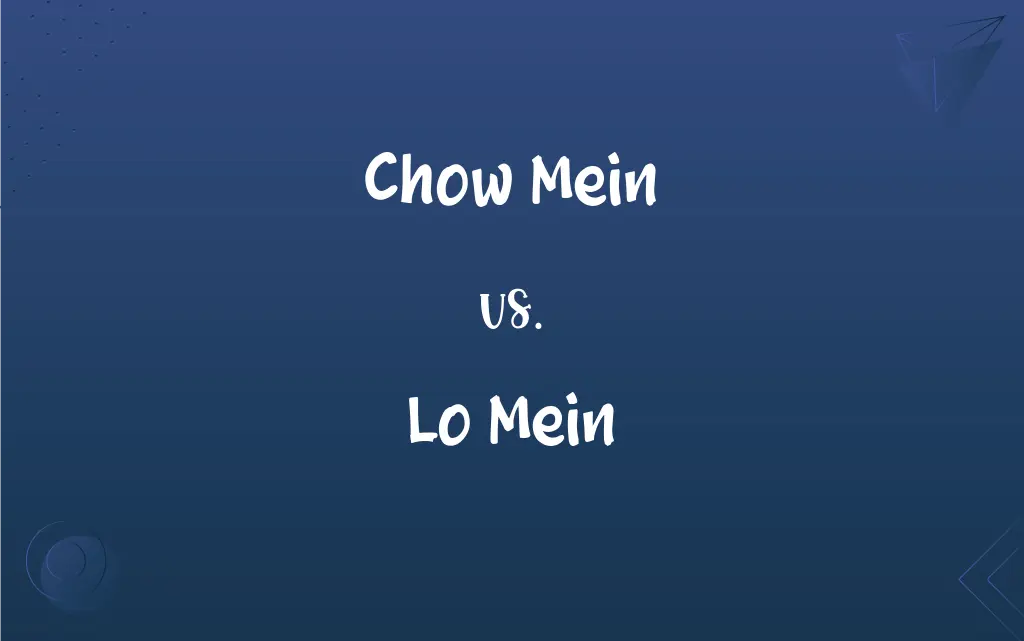Chow Mein vs. Lo Mein: What's the Difference?
Edited by Aimie Carlson || By Harlon Moss || Updated on October 12, 2023
Chow mein refers to stir-fried noodles, crisp & often served with vegetables and proteins, while lo mein involves boiled noodles mixed with cooked vegetables and protein. Both are popular Chinese dishes.

Key Differences
Chow mein is characterized by its stir-fried noodles, which provide a distinct crunchiness to the dish. The term "chow mein" translates to "stir-fried noodles" in English. In various culinary environments, chow mein presents a notable crisp texture and is often served with various vegetables and a choice of protein, such as chicken, beef, or shrimp. On the contrary, lo mein delivers a completely different mouthfeel and presentation. "Lo mein" translates to "tossed noodles" and, unlike chow mein, these noodles are boiled and then mixed with vegetables and protein, presenting a softer, chewier texture in the final dish.
Within chow mein dishes, the noodles are typically fried until they reach a crisp, golden brown texture. To many, chow mein is synonymous with a slightly crunchy, hearty noodle experience. It’s commonly coupled with a stir-fry of meat and vegetables, often brought together with a savory sauce. Conversely, lo mein adheres to a method where the noodles are boiled to a soft, pliable consistency. They are then combined with stir-fried vegetables and a protein source, and everything is tossed in a sauce that typically embraces a balance of savory, sweet, and umami flavors.
Interestingly, the ingredients besides the noodles in chow mein and lo mein dishes can be quite similar or even identical. Both dishes offer a generous serving of vegetables such as bell peppers, onions, mushrooms, and often bean sprouts, accompanied by a choice of protein. Chow mein, in its essence, provides a juxtaposition of the crispiness of the noodles against the often softer stir-fried ingredients. Lo mein, however, delivers a uniformity in its soft and luscious texture throughout the dish, offering a comforting and hearty meal where noodles, vegetables, and proteins meld harmoniously.
In a culinary context, chow mein tends to be recognized for its slight greasiness, derived from the frying process of the noodles. This aspect offers an indulgent character to the dish. Lo mein, on the other hand, often secures its appeal through a slightly glossy presentation, with noodles that carry the rich flavors of the sauce they are tossed in. Both dishes, while distinct in preparation and final presentation, hold their own unique places within Chinese cuisine, being appreciated globally for their respective flavorful and textural qualities.
Various regional adaptations also see variations within chow mein and lo mein dishes. Different areas may utilize varying types of noodles, sauce components, or additional ingredients, thereby making each version of chow mein or lo mein uniquely appealing. Regardless, whether one opts for the crisp and invigorating experience of chow mein, or the soft, succulent embrace of lo mein, both dishes hold the capacity to deliver a satisfying, flavor-rich dining experience.
ADVERTISEMENT
Comparison Chart
Noodle Texture
Fried, Crispy
Boiled, Soft
Cooking Method
Stir-fried
Boiled then Tossed
Typical Presentation
Slightly Greasy
Glossy, Saucy
Culinary Meaning
Stir-fried Noodles
Tossed Noodles
Dish Texture
Mixed (Crispy & Soft)
Uniformly Soft
ADVERTISEMENT
Chow Mein and Lo Mein Definitions
Chow Mein
Chow mein often balances the textures and flavors of crispy noodles with stir-fried vegetables and proteins, all enveloped in a savory sauce.
The shrimp chow mein offered a delightful mix of seafood flavor, crisp noodles, and colorful veggies.
Lo Mein
Lo mein dishes usually display a glossy appearance as the boiled noodles adeptly absorb the sauces they are tossed within.
The shrimp lo mein boasted a glossy, appealing look and was equally delightful in taste.
Chow Mein
Variations of chow mein can be found globally, often adapting to regional tastes and available ingredients.
The local restaurant offers a spicy version of chow mein, aligning with the regional palate.
Lo Mein
The term "lo mein" translates to "tossed noodles," reflecting the method of combining the cooked ingredients together.
For a quick, delicious dinner, we ordered lo mein with its perfectly tossed noodles and fresh veggies.
Chow Mein
Chow mein is a Chinese dish consisting of stir-fried crispy noodles, often paired with vegetables and a choice of protein.
For dinner, we enjoyed a delightful chicken chow mein with a side of spring rolls.
Lo Mein
Unlike chow mein, lo mein noodles are notably soft and chewy, having been boiled and then mixed with other cooked ingredients.
We savored every bite of the beef lo mein, appreciating its savory sauce and chewy noodles.
Chow Mein
In chow mein, the noodles are characteristically fried until they achieve a light, crunchy texture.
The crispness of the chow mein noodles provided a perfect contrast to the soft vegetables.
Lo Mein
Lo mein often showcases a melding of flavors and textures, with its soft noodles, crisp veggies, and savory sauces forming a harmonious dish.
The chicken lo mein, with its soft noodles and crisp, fresh vegetables, provided a satisfying meal.
Chow Mein
Chow mein typically presents a slightly greasy yet satisfyingly crisp noodle dish, widely appreciated in various cuisines.
The chow mein carried a flavorful blend of savory sauces, crispy noodles, and tender beef strips.
Lo Mein
Lo mein is a well-known Chinese dish featuring boiled, soft noodles tossed with stir-fried vegetables and often a protein.
The vegetable lo mein, brimming with colorful veggies, made for a vibrant and tasty lunch.
FAQs
What does "chow mein" translate to?
"Stir-fried noodles."
What texture do lo mein noodles usually have?
Soft and chewy.
Is chow mein typically crunchy or soft?
Crunchy, due to the stir-fried noodles.
Can chow mein be made gluten-free?
Yes, with the use of gluten-free noodles and sauces.
Can I find chow mein and lo mein in most Chinese restaurants?
Yes, they are commonly found in Chinese restaurants globally.
Is chow mein generally more expensive than lo mein?
Prices can vary, but there is typically not a significant cost difference.
Can I make both chow mein and lo mein at home?
Absolutely, with the right ingredients, both can be made at home.
Are the vegetable ingredients similar in both chow mein and lo mein?
Yes, both can feature a variety of stir-fried vegetables.
Can lo mein be considered a healthy dish?
It can be, especially when loaded with vegetables, but it's also crucial to consider the sodium in the sauce.
Can both chow mein and lo mein be made with various proteins?
Yes, common options include chicken, beef, shrimp, or vegetables only.
Which is typically spicier, chow mein or lo mein?
Neither is inherently spicier; spice levels can be adjusted in both dishes.
Is lo mein vegan?
It can be, but it’s essential to ensure no animal products are used in the noodles or sauce.
Is chow mein available in different regional variations?
Yes, different areas might have their own take on chow mein.
What is a key visual difference between chow mein and lo mein?
Chow mein often appears slightly crispy and less saucy, while lo mein appears glossier and softer.
How are the noodles in lo mein typically prepared?
They are boiled and then tossed with other ingredients.
Does chow mein always include meat?
No, vegetable chow mein is also a popular choice.
Are egg noodles used in lo mein?
Yes, lo mein often uses egg noodles.
Is chow mein served in a sauce?
Yes, but it’s often less saucy than lo mein due to the frying process.
Can lo mein be made without soy sauce?
Yes, alternatives or homemade sauces can be used.
What kind of noodles are used in chow mein?
Often thin, wheat-based noodles are used.
About Author
Written by
Harlon MossHarlon is a seasoned quality moderator and accomplished content writer for Difference Wiki. An alumnus of the prestigious University of California, he earned his degree in Computer Science. Leveraging his academic background, Harlon brings a meticulous and informed perspective to his work, ensuring content accuracy and excellence.
Edited by
Aimie CarlsonAimie Carlson, holding a master's degree in English literature, is a fervent English language enthusiast. She lends her writing talents to Difference Wiki, a prominent website that specializes in comparisons, offering readers insightful analyses that both captivate and inform.































































